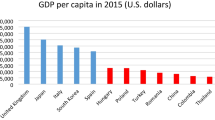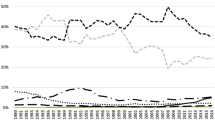Abstract
There exists a theoretically ambiguous relationship between employment volatility and trade. Using a 2006–2015 firm-level unbalanced panel dataset for South Korea, this study investigates whether the globalization of firms transmits foreign shocks to domestic employment volatility and examines how foreign shocks that affect domestic employment are transmitted during both a crisis period and a post-crisis period. My empirical findings show that foreign demand shocks to domestic employment are transmitted through inter-firm exports during a post-crisis period window, while foreign demand and supply shocks on domestic employment are transmitted through intra-firm two-way trade and intra-firm imports during a crisis period window. These results show the asymmetric response of intra-firm trade and inter-firm trade to shocks during the crisis and post-crisis periods. Therefore, these results imply structural changes to the transmission channels of foreign shocks that impact domestic employment volatility after the crisis period. In addition, foreign direct investment has a positive effect on employment volatility. This implies higher employment volatility if a firm has overseas production plants, as presence abroad prompts the firm to substitute foreign workers for domestic workers. These findings may have significant implications for policy makers seeking to identify sources of labor market instability.

Note: The first window indicates the period of 2006–2010, and the second window indicates the period of 2011–2015
Similar content being viewed by others
Notes
The dynamic panel model for employment growth model includes all firms during each window period.
Kiyota et al.’s (2020) study held that the estimation of the firm fixed effect possibly results in the situation that all time-invariant effects are absorbed by the firm fixed effect.
References
Ackerberg DA, Caves K, Frazer G (2015) Identification properties of recent production function estimators. Econometrica 83:2411–2451
Baldwin RE (ed.) (2009) The great trade collapse: causes, consequences and prospects. Cepr
Bems R, Johnson RC, Yi KM (2010) Demand spillovers and the collapse of trade in the global recession. IMF Econ Rev 58:295–326
Bems R, Johnson RC, Yi KM (2011) Vertical linkages and the collapse of global trade. Am Econ Rev 101:308–312
Blanchard O, Simon J (2001) The long and large decline in US output volatility. Brookings Pap Econ Act 1:135–164
Blundell R, Bond S (1998) Initial conditions and moment restrictions in dynamic panel data models. J Econom 87(1):115–143
Braconier H, Ekholm K (2000) Swedish multinationals and competition from high- and low-wage locations. Rev Int Econ 8:448–461
Buch CM, Döpke J, Strotmann H (2009) Does export openness increase firm-level output volatility? World Econom 32(4):531–551
Caselli F, Koren M, Lisicky M, Tenreyro S (2020) Diversification through trade. Q J Econ 135(1):449–502
Čede U, Chiriacescu B, Harasztosi P, Lalinsky T, Meriküll J (2018) Export characteristics and output volatility: comparative firm-level evidence for CEE countries. Rev World Econ 154(2):347–376
Choi MJ, Eum J (2019) Intra-firm and arm’s length trade during the global financial crisis: evidence from Korean manufacturing firms. Bank of Korea WP 2019–2013
Comin D, Mulani S (2006) Diverging trends in aggregate and firm volatility. Rev Econ Stat 88:374–383
Comin D, Philippon T (2005) The rise in firm-level volatility: Causes and consequences. NBER Macroecon Annu 20:167–201
Comin D, Groshen EL, Rabin B (2009) Turbulent firms, turbulent wages? J Monet Econ 56:109–133
Davis SJ, Haltiwanger JC, Schuh S (1996) Job creation and destruction. MIT Press
Escaith H, Lindenberg N, Miroudot S (2010) International supply chains and trade elasticity in times of global crisis. World Trade Organization (Economic Research and Statistics Division) Staff Working Paper ERSD-2010–08
Kim M (2021) Firms’ globalization and wage elasticity of labor demand in South Korea. Appl Econ 53(7):820–829
Kiyota K, Matsuura T, Higuchi Y (2020) Multinationals, intra-firm trade and employment volatility. Can J Econ Rev Canadienne Econ 53:982–1015
Konings J, Murphy A (2001) Do multinational enterprises substitute parent jobs for foreign ones? evidence from European firm level panel data. Evidence from European Firm Level Panel Data (No. 2972). CEPR Discussion Papers
Kurz C, Senses MZ (2016) Importing, exporting and firm-level employment volatility. J Int Econ 98:160–175
Lakatos C, Ohnsorge F (2017) Arm’s-length trade: a source of post-crisis trade weakness [policy research working paper]. 8144 World Bank, Washington, DC
Lanz R, Miroudot S (2011) Intra-firm trade: patterns, determinants and policy implications. OECD trade policy Papers, No. 114 OECD Publishing
Levinsohn J, Petrin A (2003) Estimating production functions using inputs to control for unobservables. Rev Econ Stud 70:317–341
McConnell MM, Perez-Quiros G (2000) Output fluctuations in the United States: What has changed since the early 1980s. Am Econ Rev 90:1464–1476
Nagengast AJ, Stehrer R (2016) The great collapse in value added trade. Rev Int Econ 24:392–421
Rodrik D (1997) Has globalization gone too far? Institute for International Economics, Washington, DC
Rovigatti G, Mollisi V (2018) Theory and practice of total-factor productivity estimation: The control function approach using Stata. Stand Genomic Sci 18(3):618–662
Senses MZ (2010) The effects of offshoring on the elasticity of labor demand. J Int Econ 81:89–98
Slaughter MJ (2001) International trade and labor-demand elasticities. J Int Econ 54:27–56
Van Beveren I (2012) Total factor productivity estimation: A practical review. J Econ Surv 26:98–128
Vannoorenberghe G (2012) Firm-level volatility and exports. J Int Econ 86:57–67
Wooldridge JM (2009) On estimating firm-level production functions using proxy variables to control for unobservables. Econ Lett 104:112–114
Yi KM (2009) The collapse of global trade: The role of vertical specialization. In: Baldwin R, Evenett S (eds) The Collapse of Global Trade, Murky Protectionism, and the Crisis: Recommendations for the G20. CEPR, London, pp 45–48
Acknowledgements
The author is grateful to the participants of the 94th Annual Conference and 16th International Conference of the Western Economic Association International, 2019 Korea's Allied Economic Associations Annual Meeting, and 2019 National Balanced Development Seminar for their comments and suggestions. The author thanks the reviewers for their thoughtful suggestions and insights.
Funding
This work was supported by the Ministry of Education of the Republic of Korea and the National Research Foundation of Korea (NRF-2019S1A5A8034490).
Author information
Authors and Affiliations
Corresponding author
Ethics declarations
Conflict of interest
The author declares that he has no conflict of interest.
Ethical approval
This article does not contain any studies with human participants or animals performed by the author.
Additional information
Publisher's Note
Springer Nature remains neutral with regard to jurisdictional claims in published maps and institutional affiliations.
This research uses Remote Access Service of Microdata Integrated Service (MDIS, RAS19051603), provided by Statistics of Korea for data analysis.
Rights and permissions
About this article
Cite this article
Kim, M. Trade and employment volatility of firms during the global financial crisis and post-crisis. Empir Econ 62, 2091–2109 (2022). https://doi.org/10.1007/s00181-021-02096-2
Received:
Accepted:
Published:
Issue Date:
DOI: https://doi.org/10.1007/s00181-021-02096-2




